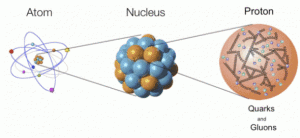Science Seen Physicist and Time One author Colin Gillespie helps you understand your world.
Atoms Are Not A-toms
So, nat’ralists observe, a flea
Hath smaller fleas that on him prey,
And these have smaller still to bite ’em
And so proceed ad infinitum.
Jonathan Swift (1733)
Once upon a time the world had a conversation about an idea called the atom. Greek philosopher Democritus kicked off the conversation around 400 BCE, saying matter’s made of tiny things that can’t be cut. A-tomos is Greek for no-cut. The conversation ended early in the 1900s: Albert Einstein showed that atoms (or what we call atoms) do exist. But these atoms are not a-toms: others cut them up into electrons and a nucleus. What’s the use of talk about a no-cut we can cut? And so it was that, in the Atomic Age, we lost what atom means.
As Irish satirist Swift suggests, in fantasy we can cut the atom up ad infinitum. But—in reality—is there a smallest particle that makes up all the larger things, like us? By definition it’s a tiny question yet the answer holds huge consequence. A true smallest particle would transform our physics. And, if history is any guide, this would in turn transform our economy.
 Physicists kept cutting for a hundred years: They routinely cut the atom’s nucleus into nucleons—protons and neutrons. In turn they cut up nucleons into quarks (though gluons keep quarks close). What’s next? The Standard Model of particle physics assumes that quarks are elementary. So far no experimental data show this to be wrong. But there are six kinds of quarks and six antiquarks. This leads some to say that maybe quarks are made of preons, though what preons are, and what they may be made of, is open to more speculation. Beyond preons Canadian physicist, Jonathan Hackett, Swift-like foresees an endless chain of cuts:
Physicists kept cutting for a hundred years: They routinely cut the atom’s nucleus into nucleons—protons and neutrons. In turn they cut up nucleons into quarks (though gluons keep quarks close). What’s next? The Standard Model of particle physics assumes that quarks are elementary. So far no experimental data show this to be wrong. But there are six kinds of quarks and six antiquarks. This leads some to say that maybe quarks are made of preons, though what preons are, and what they may be made of, is open to more speculation. Beyond preons Canadian physicist, Jonathan Hackett, Swift-like foresees an endless chain of cuts:
Moving from macroscopic objects, to atoms, to components of the nuclei, to quarks, it has been demonstrated repeatedly that the differences between supposedly fundamental particles are, in fact, merely consequences of the composite structure of underlying reality. … The difficulty is that, as such a process does not have an end, we can continue to suppose that below the currently understood structure is another set of more fundamental particles.
This kind of contra-Democritic speculation leads to a philosophic question: If we find the final cut, how will we know it’s final? There’s a speculation for this too: The true atom will not come in many kinds. There will be just one.
Soon: Is the true atom within our reach?
Sources
Jonathan Swift (1733), “On Poetry: A Rhapsody”, in The Works of Jonathan Swift (1735), vol. II, Dublin: George Faulkner, p.259; reprinted in Archibald Elias Jr. et al (1994), “The Full Text of Swift’s On Poetry: A Rhapsody 1733”, Swift Studies, p. 29; http://dspace.lafayette.edu/bitstream/handle/10385/1171/Woolley-SwiftStudies-vol9-1994.pdf
Jonathan Hackett (2007), “Locality and Translations in Braided Ribbon Networks”, arXiv.org, Ithaca: Cornell University Library, p.1, http://arxiv.org/abs/hep-th/0702198
Other reading
Colin Gillespie (2013), Time One: Discover How the Universe Began, New York: RosettaBooks, p. 354, http://www.rosettabooks.com/
Sylvia Berryman (2011), “Ancient Atomism”, Stanford Encyclopedia of Philosophy, Stanford: Stanford University, http://plato.stanford.edu/entries/atomism-ancient/
Image Source
Martin Savage, eScience Institute, University of Washington, from http://scienceblogs.com/startswithabang/2012/06/27/the-strong-force-for-beginners

No comments yet.